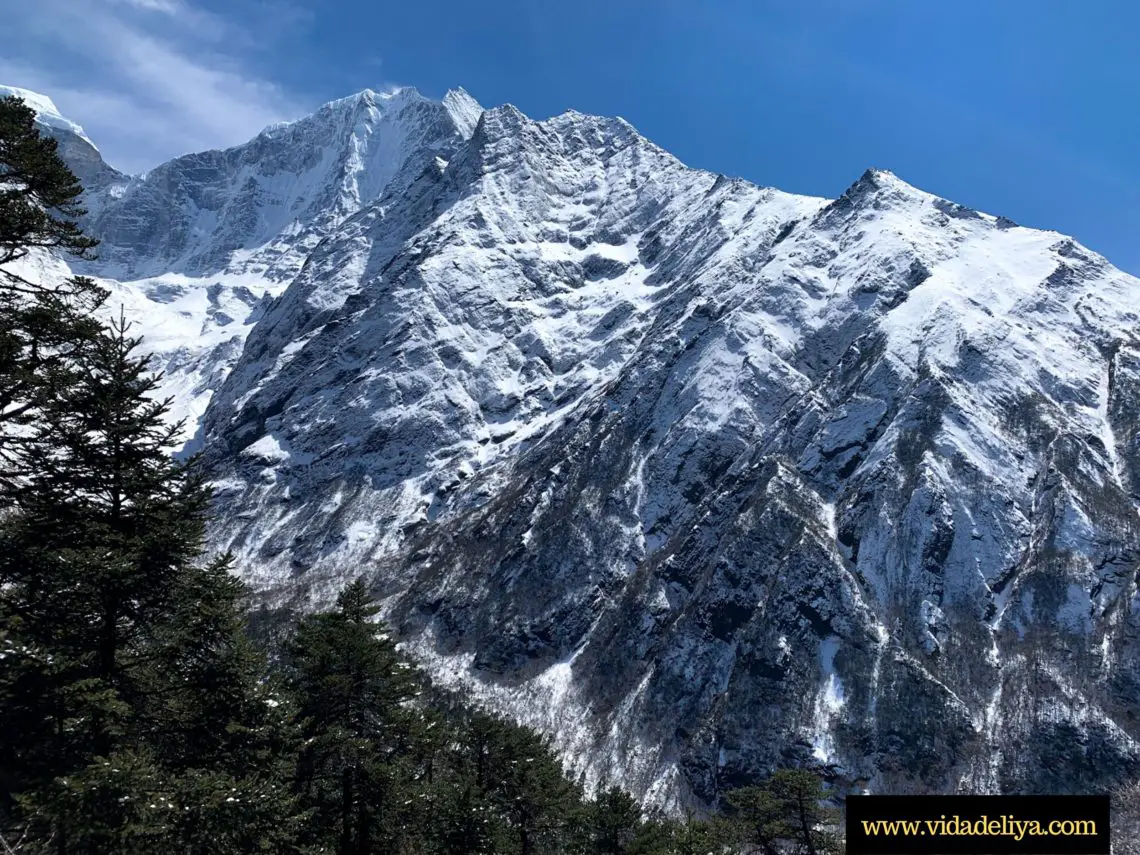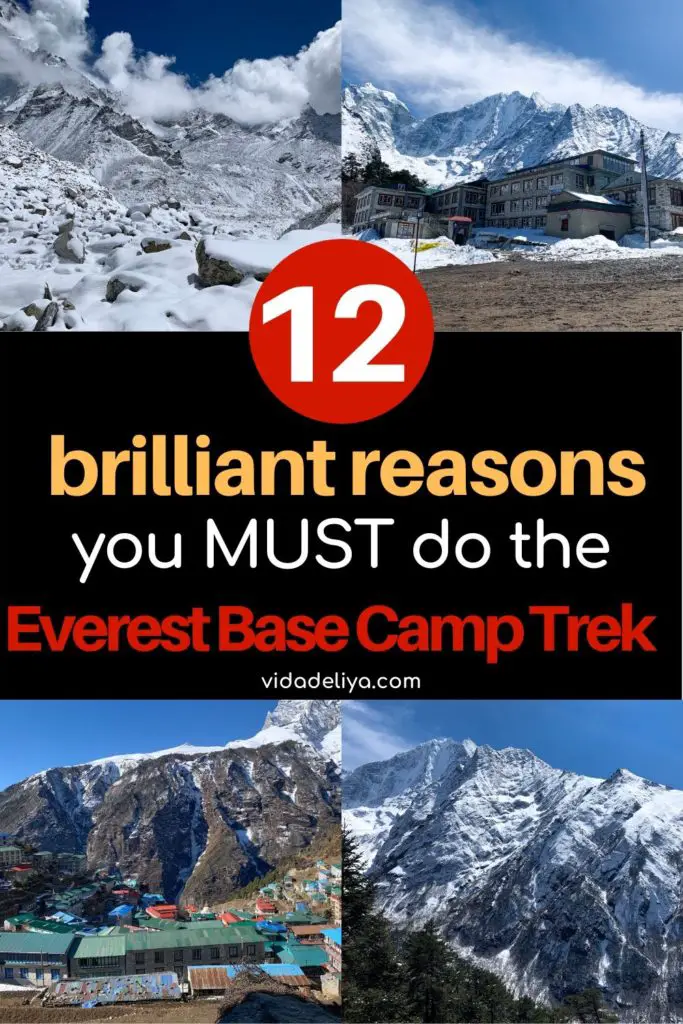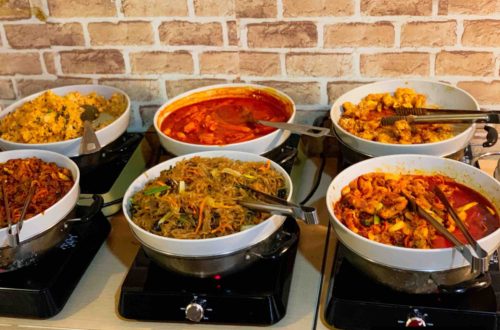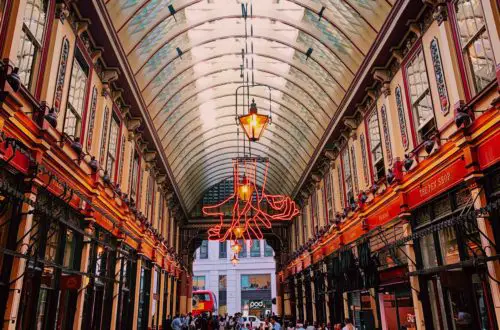
Top 12 Reasons You Should do the Everest Base Camp Trek
You might think that doing the Everest Base Camp Trek is a feat reserved only for the most elite of athletes.
You would be wrong.
With a little determination and some training (it doesn’t even have to take years!), the Everest Base Camp can be a feasible goal for you.
But if you’re wondering if the Everest Base Camp trek is worth it, then this post is for you. Read on. 😉
Table of Contents
Foreword
I thought I’d do things a little different with my Everest blog posts.
My posts are often very factual. Full of practical tips and guides on how you do things. Nuggets of information that I wish people had told me before I embarked on a certain adventure or tried out a certain restaurant.
You are still going to get all that in my Everest blog series, but I’m also doing it differently.
I’ll be telling you my story. How I felt, what I saw, who I met and what I ate as I journeyed through the Himalayan mountains in pursuit of the glittering jewel that is the Everest Base Camp. Because this adventure – hiking up to Everest Base Camp – is epic and it didn’t feel like I could fully present it without telling it the way I saw it.
Let me know if you prefer this approach?
If I’ve both entertained and educated you with these posts, then I will have achieved my goal. So let me know in the comments below!
And feel free to share this post too. 😉

Top 12 Reasons Why You Should Do the Everest Base Camp Trek
It’s an Epic Bucket List Experience

- Amount of cost involved: There is a TREMENDOUS difference in cost. The cost for EBC for trekking permits, accommodations, guides, porters, food and drinks for 15-days is around USD1500. For those who want to summit Mount Everest, the cost of the summit permit from the Nepali government alone is a non-refundable USD10,000!!! Total costs average around USD100,000 from what I understand and even that can easily go up depending on what equipment you want etc
- Amount of time involved: You can complete the EBC trek anywhere between 12-15 days (or shorter if you want to do it fast with less time set aside for acclimatisation. 15-days tend to be when you decide to go along the Chola Pass towards Gokyo-Ri.). For an Everest summit attempt, expect to spend at least 1.5 months at Everest Base Camp alone because it’s all about training and acclimatisation. Acclimatise acclimatise acclimatise!
Most people will do the EBC trek but not the summit. But it is still an epic bucket list experience to tick off if you’re in a position to do so!!
Almost anyone can do it

Don’t let the word Everest scare you off. Or the fact that the EBC route via Gokyo Ri is 150 km in total. Yes, it is an insane distance that we cover on foot but it is covered over quite a good, even relaxed spread of time.
It is doable for anyone with a reasonable level of health and fitness.
On average, we did either half-day hikes (around 4-6 hours and sometimes covering just 5 km) or full day hikes (around 7-8 hours, covering up to 10 km).
10 km sounds like a lot but in a way, you don’t really feel it. My feet never felt sore. In actuality, it just felt like a really long walk upwards, with lots of steps included (Everest Base Camp is at a pretty high altitude, after all). But even on a full-day hike, you will definitely be breaking it into two parts with lunch in between.
A typical full-day hiking schedule looks like this:
6 am: Breakfast
7 am: Start hike
11 am: Arrive at tea house for lunch
12 pm: Resume hike
3 pm: Arrive at destination
You are unlikely to arrive later than 4pm unless you are on the final push towards EBC itself in which case that day can get pretty long depending on your overall speed!!
So in essence, your hiking day will last between 7-2pm, and you have the rest of the day to relax, fuel and DRINK up, get warm and head to bed by 9pm latest.
So if you can walk over a long distance and would love to see Everest for yourself, consider the EBC trek. Seriously. It’s doable.
You Can Visit Tenzing-Hillary Airport, Lukla: The World’s Most Dangerous Airport

I don’t know about you, but I kind of like dealing with extremes. “Most exciting”, “most dangerous”, “highest”, and “fastest” are all adjectives that perk my interest.
With the EBC hike, you get to visit the World’s Most Dangerous Airport in Lukla – the gateway to the Himalayan mountains and the start of most EBC trekking adventures. Honestly, Lukla is just a small mountain town in the Khumbu Pasanglhamu rural municipality of the Solukhumbu District in north-eastern Nepal at 2860m (9383 feet). But it is a necessary stop for all Everest hiking aspirants.
There are two main ways to get to Lukla. Either you:
- go by land and hike for several days up to Lukla, or
- fly in via a tiny propeller plane.
From the domestic terminal of the Tribhuvan International Airport in Kathmandu, you will board an epic 20-passenger propeller plane from Kathmandu to Lukla.
Please note that your flight from Kathmandu to Lukla will very likely be delayed. There is no doubt about it. The delay typically lasts around 3 hours 🤷🏻♀️
In addition, flights do not fly out after 12 pm, sometimes even before that. We had a friend who couldn’t even start his EBC trek because the weather was so bad, no planes could fly out to Lukla for days. It happens because it’s all about the weather.
But what if your flight does arrive?
Firstly, the propeller plane is very small. There is only one passenger on each side of the plane. And there is NO door or barrier between the passengers and the pilot. Although the air stewardess will tell you to please not take pictures of the pilots and the cockpit (but we’d already done it as we entered the plane so 🤷🏻♀️).
The propellers are also so close to the window, I felt like I could touch them. The air stewardess will also give you a sweet and a bundle of cotton to stuff into your ears to protect yourself from the noise – DO IT! The engine noise is deafening.
Views, views, views. Before you have even started your hike, you will already gotten the most spectacular views.
How can you not want to do the Everest Base Camp trek?
The flight itself is 35 minutes. Then you come into sight of the world’s most dangerous airport: the Tenzing-Hillary Airport.
The Tenzing-Hillary Airport is situated at the edge of a cliff, and has a very short runway that slopes upwards. It is one of the shortest runways in the world, which is what makes it so dangerous and why all flights are dependent upon the weather. You only need one strong gust of wind for disaster to strike.
A little spice to the adventure, eh?
P/S: Passengers tend to burst into applause every time the plane lands successfully in the Tenzing-Hillary Airport. 😉
Meeting The Sherpas, Guides & Porters

The locals blow my mind every time I see them.
We had porters that carried two of our bags and their own every day over the same route we were using. Each bag weighs at least 10 kg, making that a total of 30 kg being lugged around one their backs.
Imagine carrying that on sea level. But then doing it at increasing altitude over long distances and terrain that constantly slopes upwards, with snow and ice and mud everywhere!
But they are also some of the most cheerful people I’ve met. It’s as if the bags they’re carrying weigh nothing as they sing going up the hill or even dance and jive to music. And they were always faster than me. 😳😔😫
I remain in awe.
And here’s a fun, personal story:
We were hiking from Tengboche down to Deboche after a snow blizzard.
The entire 30-minute downward path was treacherous beyond belief. Mud that covered the top of my boots, ice everywhere and snow that came up to my ankles.
I was slipping and sliding and would’ve most assuredly fallen if this local Nepali from Dingboche did not stop behind me, taught me where to place my feet and literally held my hand all the way down.
He did this despite having just hiked from Namche Bazaar and with a significant distance left to cover to Dingboche with his 28 kg load (what is one day’s journey to him is the equivalent of 3 days for us!!!).
His kindness touched me deeply, as did his superhuman strength!!
Sagarmatha National Park

You will spend the majority of your EBC trek in the Sagarmatha National Park. Located in the Solukhumbu district, the Sagarmatha National Park was established in 1976 and its terrain ranges from an altitude of 2845 m to 8848 m thanks to Mount Everest!!!
There are various checkpoints throughout your hike where you won’t be allowed to pass through until your guide has shown your permits. Your passport is required in this instance.
If you have a guide, that’s fantastic. He will handle all the payment and permits; you’ll just have to wait for him to catch up if you are the first of a large group of trekkers.
Sagarmatha National Park is massive.
It is a UNESCO Natural World Heritage Site full of the most incredible mountains, forests and animals like the snow leopard, Himalayan wolves, red panda, martens, langur monkey, musk deer and my personal favourite – yaks!!! There are also over 118 bird species in the national park including the yellow-billed chough, Himalayan nonaligned and blood pheasant.
There are also plenty of little villages dotted along the path to Everest Base Camp. All roads lead to the same destination so you never need to worry about getting lost. Even if you see two rods branching into different directions, just pick the wider one that looks more “used”. That’s for trekkers.
The other smaller route is used by locals and tends to be steeper/harder. Even if you use them, you will still end up in the same location.
So don’t worry about getting lost. Just enjoy the views. And those endless stairs. 😭
Yaks

This is probably just me but I knew I would love the yaks even before I encountered my first one (on my first day!!). They are huge beasts that tend to carry heavy weights on their backs and walk oh so slowly but steadily.
If you touch their fur, it radiates heat. I kid you not!! At the highest altitudes, you will find the truly shaggy-haired yaks roaming the plains, the way you would typically expect sheep to roam on the mountain side.
Absolutely incredible and a quintessential sight on the hike to Everest Base Camp. Yaks were definitely one of the biggest draws for me when I was prepping for the Everest Base Camp trek.
Hanging Bridges

Hanging bridges are also a big highlight of the Everest Base Camp trek, particularly the Hillary Bridge. You will see the Hillary Bridge on day 2 of your hike on the way to Namche Bazaar (more on that bow).
The hanging bridges hang high above the glacier river which all flow from Gokyo-Ri. If you’re afraid of heights, hanging bridges with its fluttering colourful prayer flags aren’t great.
But if you don’t mind them, get set for some of the best views from high up!
Himalayan Tea Houses

The Himalayan tea houses are your goals every single day. Trek to the next tea house, settle down, “wash” up (i.e. with baby powder and baby wipes only), and try your best to stay warm in front of the stove for the few hours it is lit before heading to bed at 9 pm.
All tea houses generally look the same: long wooden tables and chairs lining the sides of the main eating area with a giant black stove in the middle. The stove tends to be lit between the hours of 6-8pm only and left to slowly die down. If you’re in lower altitudes where the trees still grow, the stove is fueled by wood.
The stove is not lit for long not because the locals are stingy and uncaring. It’s because they are located within the Sagarmatha National Park and the Nepali government levies heavy penalties for anyone who dares to chop down the trees. Their only source of wood is the paltry amount allocated to them so they can only use so much.
When you are trekking at an altitude where no more trees survive, wood turns into yak poo. Yes, I kid you not.
The faeces of those great shaggy-haired animals are your best friend. Trust me, you will be so happy to see those great loads of dung being shoved into the fire to warm everyone in the tea house up. It also surprisingly doesn’t smell at all!
Then again, who dares. All we want is heat!!
Namche Bazaar

You might have noticed that most EBC trekking routes differ after Namche, and that’s because those routes tend to follow the pacing and physical ability of every hiking group.
A hike is not a sprint. If someone needs a longer time to acclimatise, then the length of time spent in a place is lengthened or the next destination is a mere short half-day hike from the one before.
Namche Bazaar is a place that every hiker will come by. It is also the most spectacular mountain village you will see, second only to Tengboche in my humble opinion (see below for details).
If you’ve done any research on the Everest Base Camp trek before, then you will have heard and seen photos of Namche Bazaar. It is the last and largest commercial hub in the Himalayan mountains and commonly the last place every hiker can have a hot shower (until they hike back down to Namche Bazaar again).
But you know what took me by surprise?
The fact that Namche Bazaar is essentially shaped like a half bowl and faces the most spectacular snow-capped mountains. The views are far beyond anything I could’ve imagined. Kongdi Ri, the Thamserku (we saw this stony fella all day on the trek to Namche Bazaar), and Everest are all mountains that are within easy sight of Namche Bazaar.
Oh, and Namche Bazaar also has a pretty decent bakery here. An Irish bar. Places that sell trinkets and warm clothes. And a shop selling local outdoor wear known as Sherpa: a very popular and very reputable local brand if you’re looking for warm clothes. You can also find the Sherpa brand at the end of Thamel Street in Kathmandu, near KFC.
Namche Bazaar – a mountain village that will forever be seared into my memory. Despite how cold it was for me when I was there!!!
Tengboche Monastery

The Tengboche Monastery is a very popular attraction for hikers heading to the Everest Base Camp and the final point for the “Sacred Sites Trail Project”, which is a circular trek that covers 10 monasteries in a clockwise direction with Tengboche Monastery as it’s ultimate and most spectacular destination.
This Himalayan monastery is one of the largest and most revered monasteries in the mountain and trekkers often visit it for blessings. The Buddhist murals, mani stone walls, Chortans (stupas), and multi-coloured prayer flags all add to the atmosphere. And not forgetting – the insane mountains (like Ama Dablam, Lhotse, Nuptse and Everest!!) that loom above the peak of Tengboche from every angle.
Namche Bazaar has both beauty and the most extensive amount of modern facilities in the Himalayan mountains. But Tengboche completely wins the award for most spectacular views. Hands down. Sorry, Namche Bazaar.
So while Tengboche Monastery is a highlight, I would say the entire village of Tengboche is a joy to be in.
The route from Gorak Shep to Everest Base Camp

The route from Lobuche to Gorak Shep is no joke, especially as we got hit by a snow blizzard the night before.
But the aftermath? A veritable winter wonderland even as we scaled five ridiculously high mountains. Up and down and around ice and rock, all the long way to the magical little village of Gorak Shep at 5164 m (16,942 feet). A long, long journey and one that was made so much worse because of the altitude.
But the views! The views, the views, the views. You will want these views because you are now above the clouds. And there is nothing but mountains on every side as far as the eye can see.
Everest Base Camp

Let me first be completely honest with you. The journey to get to Everest Base Camp was long, frightfully cold in the dead of winter and not a walk in the park.
And the goal at the end of this long, arduous road is just a giant rock with the words “Everest Base Camp” written on it.
That is the goal. And if you didn’t read up on this, you might even be sorely disappointed.
All that effort just for a piece of rock?!
But let me put this in perspective and tell you why that rock is more than that:
- It was truly the journey that counts. If you don’t believe me, check out the photos. There was not one day or one moment where I didn’t have spectacular views. Not one night where the view outside my bedroom wasn’t absolutely picture perfect and magical (but oh, the COLD!!! 🥶)
- You get a tremendous sense of achievement from doing something this epic
- You get to see one of the greatest wonders in the world (no exaggeration at all)
- The views around Everest Base Camp are unreal. They are spectacular. The rock is just a visible sign to show that you have arrived but the surrounding views!!! Mountains looming high above you, clouds within touching distance, the electric blue Khumbu ice falls, and snow covering every inch within sight with marble and rock peeping out from beneath it… winter was a bitter time for us to hike to EBC but it also rewarded us with views that to this day, I still can’t believe are real!
- Confidence – in knowing that you can achieve so much more than you might’ve thought you could achieve 😉
One does not stand at the base of the greatest mountain in the world and not feel a sense of awe. Of incredulity at the vast wilderness that this world possesses.
Don’t believe me? Seek out Everest Base Camp yourself! 😝
Conclusion
The top 12 reasons you should do the Everest Base Camp trek can really be summarised as below:
- The views
- The Himalayan experience; and
- The sense of achievement (bucket list ticked!)
But if you’re looking for details, worry not and stay tuned for more updates as I detail each day that passed and each and other thing you will need to execute your own epic Everest Base Camp hike!
Share this Top 12 Reasons Why You Should Do the Everest Base Camp Trek Post


You May Also Like

Wara-Wara Korean Restaurant (와라와라) – BBQ Buffet @ Solaris Mont Kiara
21st February 2020
The Bubble Tea Factory Review | Singapore’s Instaworthy Theme Park
8th January 2020
6 Comments
madhu sharma
Wow that’s a really amazing and informative guide. I never even thought of doing it but after reading this I am including this in my bucketlist 😊
Iuliya
Amazing!! I’m so glad you found this helpful 🙂
Isabella
OMG! This is on top of my list! And reading your post make me want to do it even more. Thanks for the inspiration!
Iuliya
You’re welcome!! Hope you get to do it soon 😊 Feel free to reach out if you have any questions!
Himalayan Exploration
Hello,
Thank you so much for publishing this helpful content with related pictures. This will be a great help for anyone who is looking for the Everest Base Camp trek for sure.
Really appreciated!
Iuliya
Thank you for reading!